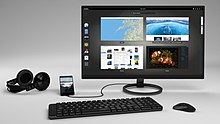Linux for mobile devices
This article needs additional citations for verification. (June 2019) |
Linux for mobile devices, sometimes referred to as mobile Linux, is the usage of Linux-based operating systems on portable devices, whose primary or only Human interface device (HID) is a touchscreen. It mainly comprises smartphones and tablet computers, but also some mobile phones, personal digital assistants (PDAs) portable media players that come with a touchscreen separately.
Mobile Linux is a relatively recent addition to the Linux range of use, with Google's Android operating system pioneering the concept. While UBPorts tried to follow suit with Ubuntu Touch, a wider development of free Linux operating systems specifically for mobile devices was only really spurred in the latter 2010s, when various smaller companies started projects to develop open source phones.
Lists
Operating systems
This is a list of Linux distros directly targeted towards use with mobile phones, being offered preconfigured with the mobile-oriented software listed below. There are both phone producers who develop their own operating systems and independent developments by community projects. Outside of these, several traditional distros have versions compiled for ARM architecture, which could be configured to use these components. This is done, for example, with Manjaro by the PinePhone.
Active
- Android
- /e/
- Android-x86
- Android Go
- EMUI (Non GMS compliant)
- Fire OS
- iodéOS
- Lineage OS
- One UI
- Replicant
- VollaOS
- Wear OS
- GrapheneOS
- Other custom Android distributions


- AsteroidOS (for wearables)
- ChromeOS (for 2-in-1 PC and Chrome Tablet)
- EMUI/HarmonyOS (EMUI 12 onwards)
- KaiOS
- Kindle firmware
- LuneOS[1] (based on HP webOS)
- Maemo Leste (fork of discontinued Maemo based on Devuan)
- Mobian (based on Debian)
- Mobile NixOS[2] (based on NixOS)
- postmarketOS (based on Alpine Linux)
- PureOS
- Sailfish OS (based on Nemo Mobile)
- SHR
- SteamOS (Powering Steam Deck)
- Tizen
- Ubuntu Touch (discontinued by Canonical, adopted by UBports Community)
- webOS
- Kali NetHunter Pro (Based on Android and Kali linux)
Discontinued
Smartphones

Phones with Linux preinstalled:
Middlewares
- BusyBox – small footprint alternative to GNU Core Utilities, under GNU GPLv2
- Fcitx
- Halium
- Intelligent Input Bus
- Maliit
- mer
- Smart Common Input Method
- Toybox – BSD licensed alternative to BusyBox
- Uim
UI
- GPE Palmtop Environment
- MauiShell (and MauiKit)[3][4][5]
- Phosh[6]
- Plasma Mobile[7]
- Lomiri (previously known as Unity8)
See also
- Anbox – allows Android apps to run on Linux distributions
References
- ^ "Running Linux on your smartphone: everything you need to know in 2019". TuxPhones - Linux on smartphones. Retrieved 2019-06-09.
- ^ "NixOS on my phone?". Mobile NixOS. Retrieved April 4, 2023.
- ^ Crume, Jacob (30 December 2021). "Maui Shell is Here, Ushering in a New Era of Desktop Linux". It's FOSS – News. Retrieved 16 January 2022.
- ^ "Maui Shell is a Beautiful Vision for the Future of Linux". OMG! Ubuntu!. 27 December 2021. Retrieved 29 January 2022.
- ^ Higuita, Camilo (26 December 2021). "Introducing Maui Shell". Nitrux. Retrieved 16 January 2022.
- ^ "Phosh". developer.puri.sm. Retrieved 2019-06-09.
- ^ "Plasma Mobile". www.plasma-mobile.org. Retrieved Oct 23, 2020.
